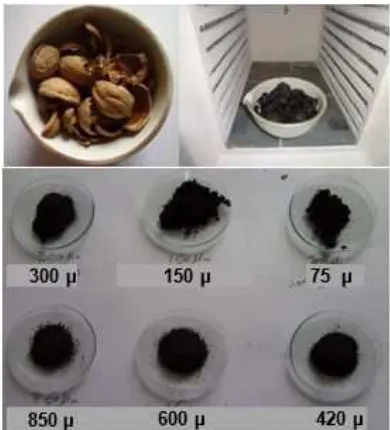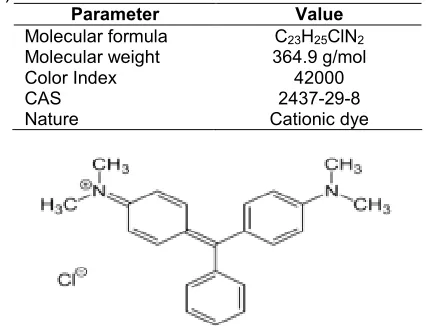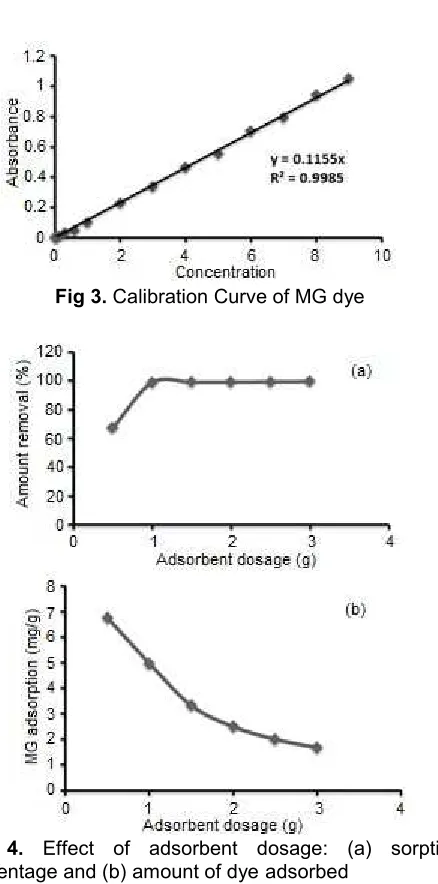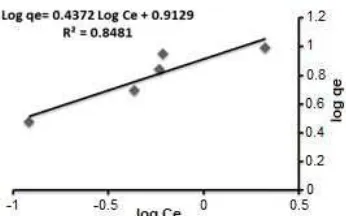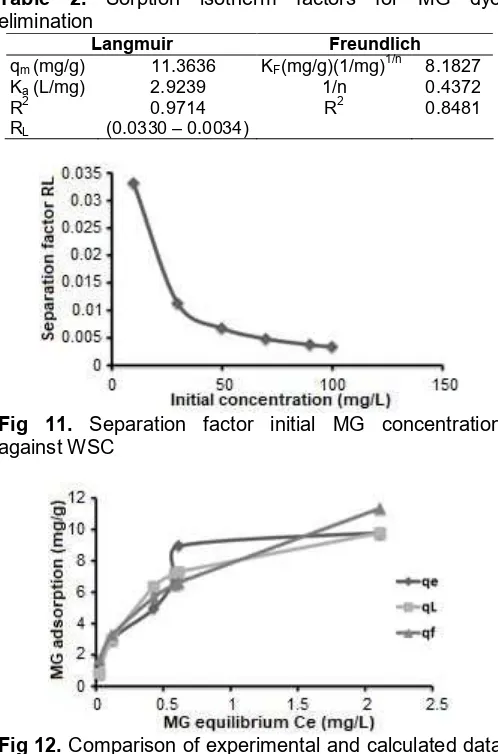Technique of Batch Adsorption for the Elimination of (Malachite Green) Dye
from Industrial Waste Water by Exploitation Walnut Shells as Sorbent
Luma Ahmed Mohammed Ali
1,*, Ahmed Saleh Farhood
1, and Firas Fadhel Ali
2 1Department of Chemistry, College of Science, University of Babylon, Babylon, Iraq 2
Department of Chemistry, College of Education for Women, University of Anbar, Anbar, Iraq
Received March 17, 2017; Accepted May 11, 2017
ABSTRACT
This study proposes an easy and cheap technique to get rid of dangerous Malachite Green (MG) dye from waste material by victimization carbon from walnut shells. The simple treatment was carried out by heating at temperature in which was set to the best carbonization degree to arrange carbon from these shells; thus, the temperature was set to 200 °C. Optimum conditions for sorption like the quantity of adsorbent, contact time, particle size of adsorbent, pH scale and initial MG concentration were conjointly examined. The results showed that the
simplest removal was obtained once victimization 1 g of carbon with particle size 150 μM and time contact 150 min.
However, the sorption of the dye was not affected by the pH except the sorption was very low at pH = 2. The removal potency was high approximating 99.53%. The results conjointly showed that the sorption equilibrium of MG onto carbon that was ready from the walnut shell has been evaluated via Langmuir and Freundlich models.
Keywords:Malachite Green; walnut shells; batch adsorption
ABSTRAK
Kajian studi ini mengusulkan teknik mudah dan murah untuk menghilangkan zat warna berbahaya Malachite Green (MG) dari bahan limbah dengan memanfaatkan karbon dari kulit walnut. Perlakuan sederhana adalah pemanasan pada temperature tertentu agar mencapai tingkat karbonisasi terbaik untuk mendapatkan karbon dari cangkang ini; untuk itu, suhu pemanasan diatur pada 200 °C. Kondisi optimum untuk penyerapan seperti jumlah adsorben, waktu kontak, ukuran partikel adsorben, skala pH dan konsentrasi MG awal juga diuji. Hasil penelitian menunjukkan bahwa penghilangan paling sederhana diperoleh pada saat pemanfaatan 1 g karbon dengan ukuran partikel 150 mikrometer dan waktu kontak 150 menit. Namun, adsorpsi zat warna tidak dipengaruhi pH kecuali adsorpsi terendah terjadi pH = 2. Potensi penghilangan cukup tinggi yaitu sebesar 99,53%. Hasil juga menunjukkan bahwa ekuilibrium sorpsi untuk MG pada karbon dari kulit walnut telah dievaluasi dengan model Langmuir dan Freundlich.
Kata Kunci:Malachite Green; kulit walnut; adsorption
INTRODUCTION
The annual rate for the assembly of dyes within the world could reach 7 million tons. These dyes are utilized in several industries like paper, plastics, leather, pharmaceutical, food, cosmetics, dyestuffs, and textiles industries [1]. An quantity of 10-15% of the dyes utilized in coloring is discharged as effluent [2]. Moreover, concerning 20% of commercial effluent is truly developed as dyes, wherever it discharged to the closest bodies of water like rivers, lacks, and seas [3]. These industrial effluents are the supply of the many pollutants like bases, acids, organics, inorganics, dissolved solids,
biodegradable with a potentiality to be of a cancer nature [5], moreover, the negative influence of those effluents isn't restricted to the unhealthful result of dyes on aquatic life, however it may cause skin irritation, dermatitis, allergies, and cancer of the human person and a few agent [6-8]. Color pollution is undesirable as a result of its prominence. It additionally works on intense the dissolved O2 and prevents the re-oxygen
There are several techniques that are wont to take away dyes from the waste like flocculation-coagulation, membrane separation, chemical oxidization, aerobic or an aerobic digestion and chemistry techniques [11]. The bulk of those techniques are of high price and cause the formation of by-products or generation of sludge [12]. The sorption technique is taken in to account the most effective among those ways owing to affordable value, high sensitivity to pollutants, simple style and operation. Besides, it doesn't turn out any harmful substances [13].
Carbon is wide accustomed take a way dyes from the effluent owing to its high sorption capability, giant extent and microporous structure. However, it's some disadvantages like low property, exhausting regeneration, and high value [14].
The physical and chemical properties of carbon depend upon the kind of raw materials used and also the activation method conditions [15]. On the premise of form and size, there are 3 styles of activation carbon fibrous, powder, and granular in line with form and size [16].
There is variety of natural adsorbents such clay [17], granular kohlrabi peel [18], peel [19], rice husk [20], raw barley straw [21], peanut husk [22], crab shell [23], and walnut shell [24]. Walnut shells are considered agricultural wastes with sensible chemical stability, high mechanical strength, simple regeneration and huge specific area. Walnut shells are utilized in the treatment of significant metals in industrial effluents like Chromium, mercury, zinc, Cesium and copper [25]. Mineral inexperienced MG may be a dyestuff that is employed for coloring several products like paper and animal skin product and for coloring wool, silk and cotton. Discharging this dye into the stream can lead to harmful effects with in the liver, the gall, the kidney, the internal organ, and therefore the gonads for the aquatic life [26], it's doable that this dye can enter into the organic phenomenon and cause cancer and agent effects on humans [27].
There are several adsorbents that are won’t to take away MG from waste matter like, lotus seed [28], durian seed based [29], weed [30], wood [31], marine protects [32] sugar canemud [33], dead leaves [34], and rice husk [35].
The present study focuses attention on the adsorption of malachite green dye on walnut shells. The walnut plant it is one of the most plant found in north of Iraq. In this study, two widely used adsorption isotherm, and kinetic study were estimated to find maximum dye removal ability and certain constants correlated to the adsorption phenomena, correspondingly. In totaling, a commercial adsorbate was used for further comparison.
Fig 1.Walnut shells before and after burn and different sizes of adsorbent
EXPERIMENTAL SECTION
Adsorbent Preparation
T
he adsorbent surface was ready via taking a quantity of walnut shells and laundry it by traditional water to get rid of dirt, then the quantity was washed with diluted HCL 0.1 M for the aim of removing soluble substances. Finally, it had been washed with H2O toget rid of the acid used. Thus, the shells became prepared for thermal activation, wherever they were placed within the melting pot and burned at 200 °C for 1 h. After this, the activated charcoal was washed by little amounts of H2O to get rid of the ash mud ensuing
from the thermal treatment method exploitation filtration funnel so it had been dried at 100 °C. Walnut shell is content: 51.2% carbon; 5.8% hydrogen; 0.51% potassium; 0.34% phosphorus; 0.14% sulphur; 0.22% magnesium; 0.12% calcium and 0.1% nitrogen and a low quantity of mineral compounds, which are considered as ash content in the walnut shell 0.9%. On the walnut shell cell surface there is a huge amount of several functional groups that are capable to deception and bond more dye and metals from solutions. The subsequent photos show the stages of the preparation of the adsorbent. The photographs show the walnut shells before and when burning at a temperature of 200 °C for 1 h. Totally different sizes of the adsorbent 75 to
Table 1. Physiochemical properties of malachite green (MG)
Parameter Value
Molecular formula C23H25ClN2
Molecular weight 364.9 g/mol
Color Index 42000
CAS 2437-29-8
Nature Cationic dye
Fig 2.The structure of malachite green dye (MG)
Adsorbent dye preparation
Malachite Green (MG) (4-{[4-(dimethylamino) phenyl] (phenyl)methyldene} -N,N -dimethylcyclohexa-2,5-dien- 1-iminium chloride).The structure of(MG) is show in Fig. 2. The physiochemical properties show in Table 1.
Stock solution was prepared by dissolving exactly 0.05 g of the dye in 500 mL of distilled water to give the concentration of 100 mg/L. The Stock solution was used to prepare another concentration, and specific density 1.18 to be diluted in 250 mL of distilled water.
Preparation of HCl solution 0.1 M
The HCL was prepared by taking 2.1 mL from concentrated HCL with 35%.
Preparation of NaOH solution 0.1 M
One gram of NaOH is prepared in a beaker to be later transferred to a volumetric flask of 250 mL which should be filled up with distilled water up to the level indicated by the mark.
Batch adsorption studies
The adsorption capacity and removal efficiency of activation carbon were calculated by the following equation:
Re moval efficiency(%)= 100
C
(2)
where qe is that the quantity of MG that adsorbate per unit weight of activated carbon (mg/g); Co the initial
concentration of MG dye at equilibrium time (mg/L); V the solution volume (L); W is that the activation carbon
Sorption isotherm model
Adsorption isotherms are thought of one in every of the essential necessities to spot the link between adsorbate and adsorbent. They are additionally of nice importance to attain the most effective style for dye removal [36]. Moreover, they are very necessary to explain variety of particles distributed between the 2 phases at the equilibrium state. Several models are utilized in the literature like Langmuir, Freundlich, Dubinin–Radushkevich, Temkin, Sips, Brouers– Sotolongo, Radke–Prausnitz and Vieth–Sladek [29]. During this study, the Langmuir and Freundlich models were chosen, as follows:
The Langmuir isotherm equation [37]
m a e
where qeis that the quantity adsorb able per unit mass
of sorbent material at equilibrium (mg/g), qm is that the
most sorption capability (mg/g), Ce is that the
equilibrium activation carbon concentration of the solution (mg/L) and Ka is that the sorption constant.
The plot of Ce/qeversus Cein equation (4) is linear this
means the sorption of MG onto activation carbon follows Irving Langmuir line.
e e
e e a m
C 1 C
q q K q (4)
The vital features of Langmuir model can be definite by a dimensional constant called equilibrium parameter, RL[38] that is definite by:
L
where b is that the Irving Langmuir constant and Co is
that the initial concentration. The worth of RL indicates
the form of the line to be either un auspicious (RL > 1),
linear (RL = 1), auspicious (0 < RL < 1) or permanent
(RL= 0).
The Freundlich isotherm equation [39]
e e f
where qeis that the quantity adsorbate per unit mass of
adsorbent at equilibrium (mg/g), Ce is that the
equilibrium MG of the solution (mg/L). Kfand n are the
Freundlich constants, n provides a sign of the favorability and Kf (mg/g (L/mg) 1/n), The values of Kf
and n is obtained from the plate of log qeversus log Ce
Fig 3.Calibration Curve of MG dye
Fig 4. Effect of adsorbent dosage: (a) sorption percentage and (b) amount of dye adsorbed
Fig 5.Effect of contact time for adsorption of MG against WSC at concentration of dye 50 mg/L, adsorbent dose of 1 g
RESULT AND DISCUSSION
Calibration Curve of MG
Various solutions of the dye are ready with concentrations starting from 0.01–9 mg/L. Spectroscopically scanning of the dye in each the ultraviolet region and also the visible region
unconcealed that the λmax= 618 nm (UV/Vis PG LTd).
Then the absorbance of the ready concentrations at this wavelength was taken as shown in Fig.3.
Effect of Amount of Adsorbent
The result of C weight on the proportion of decolorization of MG dye was investigated via taking 100 mL of 50 mg/L from dye solution in conical flasks with varied weights of C addition such as 0.5, 1, 1.5, 2, 2.5 and 3 g. The solutions were later place within the shaker (Barnstead International) for 1 h. One gram of C gave the most effective removal quantitative relation and at all-time low price, and therefore the proportion of removal ranged from 67.27% to 99.53% with the rise in weight respectively 3, as shown in Fig.4.
Effect of Contact Time
Contact time impact was examined by put 1 g of carbon in 8 conical flasks, then 100 mL of 50 mg/L was supplementary in every flask. These flasks were place within the shaker for varied durations such as 20, 30, 45, 60, 80, 120, 150 and 180 min. The Fig. 5 shows that the simplest time for equilibrium was recorded at 150 min. Later times witnessed a continuing removal proportion as a result of active sites for sorption are already saturated [19].
Effect of Particle Size of Adsorbent
Fig 6. Effect of particle size on adsorption capacity of MG onto WSC
Fig 7. Effect of pH (a) adsorption percentage and (b) amount of dye adsorbed
Fig 8.Result of initial concentration on sorption capacity of MG against WSC 150 µm bit size and 1 g sorbent dose
Fig 10. Linearized Freundlich model sorption isotherm model of MG onto WSC
relation gets higher once the scale equals 0.15 mL as shown in Fig. 6. The explanation is that the little size of the particle of the adsorbent provides a bigger area that will increase the amount of active sites [40].
Effected of pH
The result of pH scale on the sorption of dye via WSC was applied by taking 6 conical flasks to be full of 100 mL of the dye with an initial concentration of 50 mg/L. The pH scale was adjusted by 0.1 N HCL or 0.1 N NaOH exploitation the pH scale meter (WTW). One
gram of WSC that contains a particle size of 150 μM
with varied pH scale 2, 3, 4.3, 5, 6, and 8 was more to every flask. The flasks were then place in an exceedingly shaker for 150 min. The Fig.7 shows that there was no important result of pH scale on the adsorption process [30].
Effect of Initial MG Concentration
To identify the result of initial dye concentration on the sorption ability, totally different concentrations of MG dye 10, 30, 50, 70, 90 and 100 mg/L were taken and else to 6 conical flasks that contain 1 g of WSC
with 150 μM particle size. These flasks were later place
during a shaker for 150 min. The results obtained indicated that the sorption capability raised from 0.99 to 9.78 mg/g with the rise of the concentration of the dye from 10 to 100 mg/L, Fig.8.
Isothermal Analysis
Fig. 9 shows Langmuir line for MG sorption above Walnut shells carbon and Fig. 10 represent Freundlich line for (MG) sorption. The premeditated isothermal sorption limits of Langmuir and Freundlich of MG is abridged in Table 2.
Table 2. Sorption isotherm factors for MG dye elimination
Langmuir Freundlich
qm(mg/g) 11.3636 KF(mg/g)(1/mg)1/n 8.1827
Ka(L/mg) 2.9239 1/n 0.4372
R2 0.9714 R2 0.8481
RL (0.0330 – 0.0034)
Fig 11. Separation factor initial MG concentration against WSC
Fig 12.Comparison of experimental and calculated data by Langmuir and Freundlich equilibrium isotherm models
surface of Walnut shells carbon.
The separation issue RL values are often revealed by Fig. 11, that they're within the vary of 0–1, demonstrating that the sorption was satisfactory method [32,41-42].
From Freundlich isotherm, the worth of 1/n, the Freundlich limit, that was between 0–1 additionally confirmed that the sorption was favorable and useful as low price sorbent [24,41-43].
The larger worth of KF, the upper the sorption, because, this worth indicates to additional heterogeneous the surface once it'll nearer the zero 10. The Walnut shells carbon, studied as adsorbent for removal of MG, well-tried that it mechanisms well. The sorption submitted each Freundlich and Langmuir isotherms exhibiting heterogeneous surface circumstances and monolayer sorption 2. Fig 12 explains the aberration of those models from the investigational information. It seems that the sorption of
MG on Walnut shells carbon may be well fitted by the tow isotherms.
CONCLUSION
The definitions of this work expose that the Walnut shells carbon (WSC) that merely and plentifully accessible agro north in our country could also be simply rehabilitated into wise adsorbent by exploitation simple ways in which an applicable quantity 1 g/L of the Walnut shells carbon adsorbent would possibly removal the most amount as 99 exploit the dye from an solution 50 ppm if stressed for 150 min incontestable enough probable of Walnut shells carbon as an sorbent for the deletion of the MG dye, from water solutions. The sorption of the MG was most round the natural pH of the solution of metal. This displays that sorption of the dye could be disbursed on WSC with applying every Langmuir and Freundlich isotherm.
REFERENCES
[1] Afkhami, A. and Moosavi, R., 2010, Adsorptive removal of Congo red, a carcinogenic textile dye, from aqueous solutions by magnetite nanoparticles, J. Hazard. Mater., 174 (1-3), 398–403.
[2] Lian, L., Guo, L., and Guo, C., 2009, Adsorption of Congo red from aqueous solutions onto Ca-bentonite,J. Hazard. Mater., 161 (1),126–131. [3] Gupta, V.K., Jain, R., Mittal, A., Saleh, T.A.,
Nayak, A., Agarwal, S., and Sikarwar, S., 2012, Photo-catalytic degradation of toxic dye amaranth on TiO2/UV in aqueous suspensions, Mater Sci.
Eng., C, 32 (1), 12–17.
[4] Naser, N.A., Kadim, K.H., and Taha, D.N., 2012, Synthesis and characterization of an organic reagent 4-(6-bromo-2-benzothiazolylazo) pyrogallol and its analytical application, J. Oleo Sci., 61 (7), 387–392.
[5] Baskaralingam, P., Pulikesi, M., Elango, D., Ramamurthi, V., and Sivanesan, S., 2006, Adsorption of acid dye onto organo bentonite, J. Hazard. Mater., 128 (2-3),138–144.
[6] Feng, Y., Dionysiou, D.D., Wu, Y., Zhou, H., Xue, L., He, S., and Yang, L., 2013, Adsorption of dyestuff from aqueous solutions through oxalic acid-modified swede rape straw: Adsorption process and disposal methodology of depleted bio adsorbents,Bioresour. Technol., 138, 191–197. [7] Abbas, G.J., Mashkour, M.S., and Taha, D.N.,
2016, Flow injection spectrophotometric determination of penicillamine in pharmaceutical formulation using 1,2-naphthoquine-4-sulfonate ,
[8] Taha, D.N., Obaid, Z.S., 2016, Designing flow injection unit for chromates determining, Res. J. Pharm. Biol. Chem. Sci., 7 (6), 2241–2250.
[9] Koprivanac, N., and Kusic, H., 2008, Hazardous organic pollutants in colored wastewaters, Nova Science Publishers, New York.
[10] Crini, G., 2006, Non-conventional low-cost adsorbents for dye removal: A review, Bioresour. Technol., 97 (9), 1061–1085.
[11] Mahmoodi, N.M., 2013, Zinc ferrite nanoparticle as a magnetic catalyst: Synthesis and dye degradation,
Mater. Res. Bull., 48 (10), 4255–4260.
[12] Hameed, B.H., and El-Khaiary, M.I., 2008, Equilibrium, kinetics and mechanism of malachite green adsorption on activated carbon prepared from bamboo by K2CO3 activation and subsequent
gasification with CO2, J. Hazard. Mater., 157 (2-3),
344–351.
[13] Aksu, Z., 2005, Application of bio sorption for the removal of organic pollutants: A review, Process Biochem., 40 (3-4), 997–1026.
[14] El Nemr, A., Abdelwahab, O., EI-Sikaily, A., and Khaled, A., 2009, Removal of direct blue-86 from aqueous solution by new activated carbon developed from orange peel, J. Hazard. Mater., 161 (1),102–110.
[15] DiPanfilo, R., and Nosa O. Egiebor, N.O., 1996, Activated carbon production from synthetic crude coke,Fuel Process. Technol., 46 (3), 157–169.
[16] Khalili, N.R., Campbell, M., Sandi, G., and Golaś, J.,
2000, Production of micro- and mesoporous activated carbon from paper mill sludge: I. Effect of zinc chloride activation, Carbon, 38 (14), 1905–1915.
[17] Taha D.N., and Samaka, I.S., 2012, Natural Iraqi palygorskite clay as low cost adsorbent for the treatment of dye containing industrial wastewater,J. Oleo Sci., 61 (12), 729–736.
[18] Gong, R., Zhang, X., Liu, H., Sun, Y., and Liu, B., 2007, Uptake of cationic dyes from aqueous solution by bio sorption onto granular kohlrabi peel,
Bioresour. Technol., 98 (6), 1319–1323.
[19] Kumar, K.V., 2007, Optimum sorption isotherm by linear and non-linear methods for malachite green onto lemon peel,Dyes Pigm., 74 (3), 595–597. [20] Kumar, O., and Bandyopadhyay, M., 2006, Sorption
of cadmium from aqueous solution using pretreated rice husk,Bioresour. Technol., 97 (1), 104–109. [21] Husseien, M., Amer, A.A., El-Maghraby, A., and
Nahla, A., 2007, Utilization of barley straw as a source of a activated carbon for removal of methylene blue from aqueous solution,J. Appl. Sci. Res., 3 (11), 1352–1358.
agricultural waste maize bran,Bioresour. Technol., 97 (16), 2124–2130.
[23] Vijayaraghavan, K., Palanivelu, K., and Velan, M., 2006, Biosorption of copper(II) and cobalt(II) from aqueous solutions by crab shell particles,
Bioresour. Technol., 97 (12), 1411–1419.
[24] Ding, D.H., Zhao, Y.X., Yang, S.J., Shi, W.S., Zhang, Z.Y., Lei, Z.F., and Yang, Y.N., 2013, Adsorption of cesium from aqueous solution using agricultural residue – Walnut shell: Equilibrium, kinetic and thermodynamic modeling studies,
Water Res., 47 (7), 2563–2571.
[25] Pehlivan, E., and Altun, T., 2008 Biosorption of chromium(VI) ion from aqueous solutions using walnut, hazelnut and almond shell, J. Hazard. Mater., 155 (1-2), 378–384.
[26] Daneshvar, N., Ayazloo, M., Khataee, A.R., and Pourhassan, M., 2007, Biological decolorization of dye solution containing malachite green by microalgae Cosmarium sp., Bioresour. Technol., 98, 1176–1182.
[27] Al-Degs, Y., Khraisheh, M.A.M., and Ahmed M.N., 2000, Evaluation of activated carbon adsorbents for the removal of textile reactive dyes from wastewater, Jordan Int. Chem. Eng. Conf., 1, 159–167.
[28] Nethaji, S., Sivasamy, A., Kumar, R.V., and Mandal, A.B., 2013, Preparation of char from lotus seed biomass and the exploration of its dye removal capacity through batch and column adsorption studies, Environ Sci. Pollut. Res, 20 (6), 3670–3678.
[29] Ahmad, M.A., Ahmad, N., and Bello, O.S., 2014, Adsorptive removal of malachite green dye using durian seed-based activated carbon, Water Air Soil Pollut., 225, 2057.
[30] Wang, X.S., 2010, Invasive freshwater macrophyte alligator weed: Novel adsorbent for removal of malachite green from aqueous solution,
Water Air Soil Pollut., 206 (1), 215–223.
[31] Song, Y., Ding, S., Chen, S., Xu, H., Mei, Y., and Ren, J., 2015, Removal of malachite green in aqueous solution by adsorption on sawdust,
Korean J. Chem. Eng.,32 (12), 2443–2448. [32] Bekçi, Z., Seki, Y., and Cavas, L., 2009, Removal
of malachite green by using an invasive marine alga Caulerpa racemosa var. cylindracea, J. Hazard. Mater., 161 (2-3), 1454–1460.
[33] Khattri, S.D., and Singh, M.K., 1999, Colour removal from dye wastewater using sugar cane dust as an adsorbent, Adsorpt. Sci. Technol., 17 (4), 269–282.
Equilibrium and kinetic modeling, Chem. Eng. J., 143 (1-3), 73–84.
[35] Guo, Y., Yang, S., Fu, W., Qi, J., Li, R., Wang, Z., and Xu, H., 2003, Adsorption of malachite green on micro- and mesoporous rice husk-based active carbon,Dyes Pigm., 56 (3), 219–229.
[36] Xia, C., Jing, Y., Jia, Y., Yue, D., Ma, J., and Yin, X., 2011, Adsorption properties of congo red from aqueous solution on modified hectorite: Kinetic and thermodynamic studies, Desalination, 265 (1-3), 81–87.
[37] Langmuir, I., 1918, The adsorption of gases on plan surface of glass, mica and platinum, J. Am. Chem. Soc., 40 (9), 1361–1403.
[38] Weber, T.W., and Chakravorti, R.K., 1974, Pore and solid diffusion models for fixed-bed absorbers,
AlChE J., 20 (2), 228–238.
[39] Freundlich, H.M.F., 1906, Over the adsorption in solution,J. Phys. Chem., 57, 385–470.
[40] Taha, D.N., Samaka, I.S., and Mohammed, L.A., 2013, Adsorptive removal of dye from industrial effluents using natural Iraqi palygorskite clay as low cost adsorbent, J. Asian Sci. Res., 3 (9), 945–955.
[41] Taha, D.N., Samaka, I.S., Mohammed, L.A., and Naige, A.S., 2014, Adsorption studies of direct red 28 dye onto activated carbon prepared from low-cost material,Civ. Environ. Res., 6 (7), 149–159. [42] Sulistyaningsih, T., Santosa, S.J., Siswanta, D.,
Rusdiarso, B., 2016, Adsorption of [AuCl4]
-on ultrasonically and mechanical-stirring assisted Mg/Al-NO3 hydrotalcite-magnetite, Indones. J.
Chem., 16 (3) 268–276.
